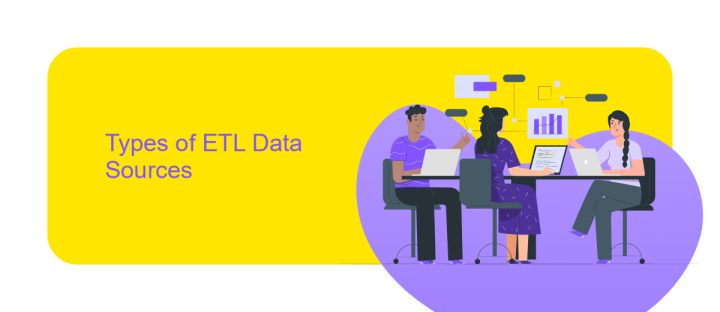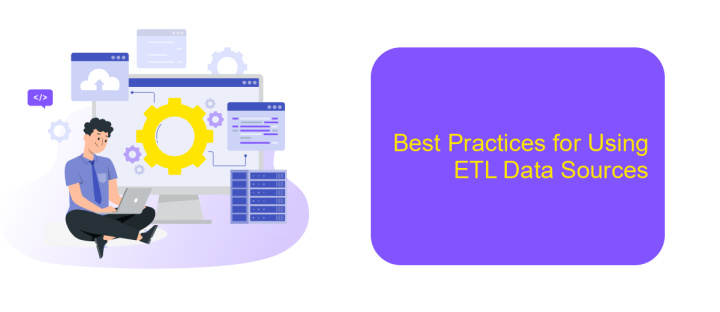ETL Data Sources
Extract, Transform, Load (ETL) processes are essential for data integration and management in modern enterprises. ETL data sources, which include databases, cloud services, and flat files, serve as the foundation for these processes. Understanding the various types of ETL data sources is crucial for optimizing data workflows, ensuring data quality, and enabling effective decision-making.
Introduction
ETL (Extract, Transform, Load) processes are crucial for integrating data from various sources into a unified data warehouse. These processes enable businesses to gather, clean, and consolidate data, ensuring that insights derived are accurate and reliable. Understanding the different types of ETL data sources is essential for effective data management and analytics.
- Relational Databases: These include SQL databases like MySQL, PostgreSQL, and Oracle.
- NoSQL Databases: Examples are MongoDB, Cassandra, and Couchbase.
- APIs: Services like ApiX-Drive facilitate seamless integration with various APIs, simplifying data extraction and transformation.
- Flat Files: CSV, XML, and JSON files stored on servers or cloud storage.
- Cloud Services: Data from platforms such as AWS, Google Cloud, and Azure.
Effective ETL solutions not only streamline the data integration process but also enhance the quality and accessibility of data. Tools like ApiX-Drive play a vital role in automating and simplifying the extraction and transformation stages, allowing businesses to focus on deriving actionable insights. By leveraging diverse data sources, organizations can achieve a comprehensive view of their operations and make informed decisions.
Types of ETL Data Sources

ETL (Extract, Transform, Load) processes rely on various data sources to gather and transform information for analytical purposes. The primary types of ETL data sources include databases, which store structured data in tables and rows, and can be accessed using SQL queries. Another significant type is flat files, such as CSV or Excel files, which are often used for storing and exchanging data due to their simplicity and ease of use. Additionally, APIs (Application Programming Interfaces) play a crucial role in modern ETL processes, enabling seamless data extraction from web services and applications.
Cloud storage solutions like Amazon S3 and Google Cloud Storage are also popular ETL data sources, providing scalable and reliable storage for large datasets. Furthermore, streaming data sources, such as Apache Kafka and real-time event hubs, allow for the continuous ingestion of data, which is essential for real-time analytics. Tools like ApiX-Drive facilitate the integration of various data sources by automating the data extraction and transformation processes, ensuring that businesses can efficiently manage their ETL workflows without extensive manual intervention.
Considerations for Choosing ETL Data Sources

When selecting ETL data sources, it's crucial to consider several factors to ensure efficient data integration and processing. The right choice of data sources impacts the accuracy, reliability, and performance of your ETL processes.
- Data Compatibility: Ensure the data source formats are compatible with your ETL tools to avoid extensive data transformation efforts.
- Data Volume: Assess the volume of data and its growth rate to ensure your ETL infrastructure can handle it efficiently.
- Data Quality: Evaluate the quality of data from the sources to minimize the need for data cleansing and transformation.
- Integration Capabilities: Consider using integration services like ApiX-Drive to streamline the connection between various data sources and your ETL system.
- Cost: Analyze the cost implications of using different data sources, including licensing, maintenance, and operational costs.
By carefully evaluating these factors, you can choose ETL data sources that not only meet your current needs but also support future scalability and performance requirements. Leveraging tools and services like ApiX-Drive can further simplify the integration process, ensuring seamless data flow across your systems.
Best Practices for Using ETL Data Sources

When working with ETL data sources, it's crucial to follow best practices to ensure data integrity, efficiency, and scalability. Start by identifying the specific needs and objectives of your ETL process, as this will guide your choice of data sources and tools.
Next, ensure that your data sources are reliable and up-to-date. Regularly audit your data sources to confirm their accuracy and consistency. This can prevent issues down the line and ensure that your ETL process runs smoothly.
- Use incremental data loading to minimize the impact on source systems and improve performance.
- Implement robust error handling and logging mechanisms to quickly identify and resolve issues.
- Leverage data integration tools like ApiX-Drive to automate and streamline the integration process.
- Ensure data security by encrypting sensitive information and adhering to compliance standards.
Finally, continuously monitor and optimize your ETL processes. Regularly review performance metrics and make adjustments as needed to maintain efficiency. By following these best practices, you can create a reliable and effective ETL system that meets your organization's data needs.
- Automate the work of an online store or landing
- Empower through integration
- Don't spend money on programmers and integrators
- Save time by automating routine tasks
Conclusion
In conclusion, ETL data sources play a critical role in the data integration process, enabling organizations to extract, transform, and load data from various systems into a centralized repository. This process ensures that data is consistent, accurate, and ready for analysis, driving informed decision-making. By leveraging diverse data sources, businesses can gain comprehensive insights and maintain a competitive edge in their respective industries.
Moreover, the use of integration services like ApiX-Drive can significantly streamline the ETL process. ApiX-Drive offers a user-friendly platform that simplifies the connection between different applications and data sources, reducing the complexity of data integration. By automating data workflows, ApiX-Drive enhances efficiency and allows organizations to focus on deriving value from their data rather than being bogged down by technical challenges. Embracing such tools is essential for modern businesses aiming to optimize their data management strategies.
FAQ
What is ETL in the context of data sources?
What types of data sources can be used in an ETL process?
How do I automate the ETL process for my data sources?
What are some common challenges with ETL data sources?
How can I ensure data quality in my ETL process?
Routine tasks take a lot of time from employees? Do they burn out, do not have enough working day for the main duties and important things? Do you understand that the only way out of this situation in modern realities is automation? Try Apix-Drive for free and make sure that the online connector in 5 minutes of setting up integration will remove a significant part of the routine from your life and free up time for you and your employees.


